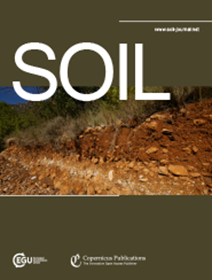Gradual drying of permafrost peat decreases carbon dioxide production in drier peat plateaus but not in wetter fens and bogs
IF 4.3
2区 农林科学
Q1 SOIL SCIENCE
引用次数: 0
Abstract
Abstract. Permafrost thawing of northern peatlands can cause the local collapse of peat plateaus into much wetter thermokarst bogs and fens, dominated by Sphagnum mosses and graminoids, respectively. However, permafrost thaw can also improve landscape drainage and, thus, lead to the regional drying of peatlands. How gradual drying of these thawing permafrost peatlands affects the subsequent microbial production of carbon dioxide (CO2) and nitrous oxide (N2O) is uncertain because of landscape heterogeneity in moisture, peat quality, and vegetation. Here, we collected near-surface peat samples (5–20 cm) from Alberta, Canada, across transects representing a thaw gradient from peat plateaus to a fen or bog. We incubated the samples for 2 weeks under either field moisture or under gradual drying to reduce moisture by ∼ 80 %. Only the fen sites, which had high moisture and a high percentage of total N, produced N2O (0.06–6.7 µg N2O-N per gram of dry peat), but N2O production was unaffected by the drying treatments. Peat CO2 production was greatest from the fen and the youngest stage of the thermokarst bog, despite them having the most water-saturated field conditions, likely reflecting their more labile plant inputs and, thus, more decomposable peat. We found that CO2 respiration was enhanced by drying at relatively wet sites like the fens and young bog but was suppressed by drying in relatively drier peat plateaus. Further, gradual drying increased 13C-CO2 respiration, suggesting a possible shift to more decomposed, older C being lost with peat drying. Thus, our study suggests that future peat CO2 and N2O production from peatlands will depend on whether peat plateaus thaw into fens or bogs and on their diverging responses of peat respiration to more moisture-limited conditions.永久冻土泥炭的逐渐干燥会减少干燥泥炭高原的二氧化碳产量,而湿润沼泽和沼泽则不会
摘要。北部泥炭地的永久冻土融化会导致泥炭高原局部塌陷,变成更湿润的热岩溶沼泽和沼泽,分别以泥炭藓和禾本科植物为主。然而,永久冻土解冻也可以改善景观排水,从而导致泥炭地的区域干燥。这些融化的永久冻土泥炭地的逐渐干燥如何影响随后的二氧化碳(CO2)和氧化亚氮(N2O)的微生物生产是不确定的,因为湿度、泥炭质量和植被的景观异质性。在这里,我们从加拿大阿尔伯塔省收集了近地表泥炭样本(5-20厘米),横跨代表从泥炭高原到沼泽或沼泽的融化梯度的样带。我们将样品在田间湿度或逐渐干燥条件下孵育2周,以减少水分约80%。只有湿度高、总氮含量高的沼泽区产生N2O(每克干泥炭0.06 ~ 6.7µg N2O-N),但N2O产量不受干燥处理的影响。泥炭二氧化碳产量最大的是沼泽和热岩溶沼泽的最年轻阶段,尽管它们具有最饱和的田间条件,可能反映了它们更不稳定的植物输入,因此更容易分解泥炭。我们发现,在相对潮湿的地方,如沼泽和幼沼泽,干燥会增强二氧化碳呼吸,而在相对干燥的泥炭高原,干燥会抑制二氧化碳呼吸。此外,逐渐干燥增加了13C-CO2的呼吸作用,这表明随着泥炭的干燥,可能会发生更分解、更古老的碳流失的转变。因此,我们的研究表明,未来泥炭地的泥炭CO2和N2O产量将取决于泥炭高原是解冻为沼泽还是沼泽,以及它们对更多水分限制条件下泥炭呼吸的不同响应。
本文章由计算机程序翻译,如有差异,请以英文原文为准。
求助全文
约1分钟内获得全文
求助全文
来源期刊

Soil
Agricultural and Biological Sciences-Soil Science
CiteScore
10.80
自引率
2.90%
发文量
44
审稿时长
30 weeks
期刊介绍:
SOIL is an international scientific journal dedicated to the publication and discussion of high-quality research in the field of soil system sciences.
SOIL is at the interface between the atmosphere, lithosphere, hydrosphere, and biosphere. SOIL publishes scientific research that contributes to understanding the soil system and its interaction with humans and the entire Earth system. The scope of the journal includes all topics that fall within the study of soil science as a discipline, with an emphasis on studies that integrate soil science with other sciences (hydrology, agronomy, socio-economics, health sciences, atmospheric sciences, etc.).
 求助内容:
求助内容: 应助结果提醒方式:
应助结果提醒方式:


